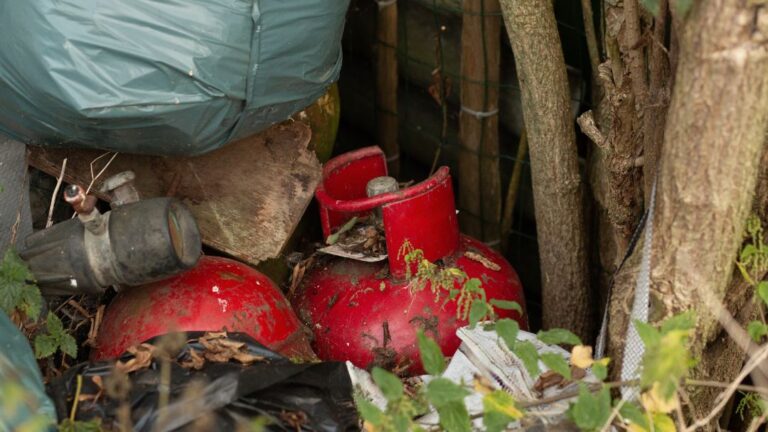Proper storage of drums containing hazardous materials is essential for workplace safety and regulatory compliance.
The Occupational Safety and Health Administration (OSHA) has outlined specific OSHA drum storage requirements to ensure flammable and hazardous substances are stored safely, preventing accidents and ensuring a safe environment for employees.
OSHA Drum Storage Requirements
When storing flammable liquids, OSHA specifies different limits based on the type of liquid and the type of container used.
If you use a storage cabinet, it must meet OSHA standards. The limits for cabinet storage are:
- Category 1, 2, or 3 Liquids: Maximum of 60 gallons
- Category 4 Liquids: Maximum of 120 gallons
Metal Cabinets (per 29 CFR 1910.106(d)(3)(ii)(a)):
- Constructed from at least No. 18 gauge sheet steel
- Double-walled with a 1½-inch airspace
- Riveted, welded, or similarly sealed joints
- Three-point latch on doors
- Raised door sills of at least 2 inches to contain spills
- Labeled “Flammable—Keep Fire Away” in clear lettering
Wood Cabinets (per 29 CFR 1910.106(d)(3)(ii)(b)):
- Constructed from exterior-grade plywood, at least 1 inch thick
- Fire-resistant and non-delaminating
- Joints fastened in two directions with flathead screws
- Doors with a rabbeted overlap of at least 1 inch
- Fire-resistant latches and hinges
- Labeled “Flammable—Keep Fire Away” in clear lettering
Storage of Large Quantities of Flammable Liquids
For large volumes of flammable liquids, specialized storage systems are required. These may include indoor or outdoor storage facilities or permanent tanks that meet the standards outlined in OSHA 1910.106.
For smaller amounts, OSHA allows storage in approved containers or portable tanks. The limits are as follows:
| Container Type | Category 1 | Category 2 | Category 3 | Category 4 |
| Glass or Approved Plastic | 1 pint | 1 quart | 1 gallon | 1 gallon |
| Metal (non-DOT drums) | 1 gallon | 5 gallons | 5 gallons | 5 gallons |
| Safety Cans | 2 gallons | 5 gallons | 5 gallons | 5 gallons |
| DOT-approved Metal Drums | 60 gallons | 60 gallons | 60 gallons | 60 gallons |
| Approved Portable Tanks | 660 gallons | 660 gallons | 660 gallons | 660 gallons |
Hazardous Chemical Storage
To prevent accidents, OSHA provides guidelines for the safe storage of hazardous chemicals.
Employers must ensure that storage areas are free from hazards like clutter and debris, which increase fire risks. OSHA also recommends the following precautions:
- Store hazardous materials at least 10 feet away from exterior walls.
- Keep incompatible chemicals separate to avoid dangerous reactions (e.g., fire, explosion, or toxic release).
- Avoid stacking hazardous materials above eye level or in a way that risks imbalance.
Best Practices:
- Label all containers properly to ensure safe handling and storage.
- Regularly inspect storage areas for potential hazards such as leaks or temperature variations.
- Implement employee training on how to handle hazardous materials safely.
What Chemicals Should Not Be Stored Together?
Storing incompatible chemicals in close proximity can lead to hazardous reactions, including fires, explosions, or toxic releases.
These are five common chemicals and their incompatible counterparts:
- Water (H₂O): Water reacts dangerously with many chemicals, including acetyl chloride, chromic acid, sulfuric acid, and sulfur trioxide.
- Nitric Acid: Commonly found in fertilizers and explosives, nitric acid should not be stored near acetone, acetic acid, alcohol, chromic acid, aniline, hydrocyanic acid, hydrogen sulfide, or flammable substances.
- Zinc Powder: Zinc powder should be kept away from sulfur in paint, cosmetics, and batteries.
- Oxygen: Store oxygen away from hydrogen, flammable substances, oil, and grease to avoid combustion risks.
- Chlorine: Chlorine should not be stored near ammonia, acetylene, benzene, butadiene, hydrogen, petroleum gasses, sodium carbide, or turpentine due to the risk of violent reactions.

OSHA Compliance
When OSHA compliance officers issue citations, they typically come with penalties based on the severity of the violation.
Penalties are assessed according to the gravity of the violation, the size of the business, the employer’s good faith, and the employer’s history of previous violations.
OSHA violations are categorized into several types, each with different penalties:
- Other-Than-Serious/Serious Violations: These involve conditions that affect safety or health but are unlikely to cause death or serious harm. Employers may face penalties of up to $16,131 per violation. Multiple other-than-serious violations may be grouped and treated as serious violations.
- Failure to Abate Violation: The involved individuals will need to pay $16,131 per day beyond the abatement date.
- Willful or Repeated Violations: These show that an employer intentionally disregarded OSHA standards. Penalties range from $161,323 per violation.
What to Do When Drums Are Used Up?
Once you’ve emptied your storage drums, it’s important to handle them properly to prevent contamination or safety hazards.
First, make sure the drums are completely empty, as any remaining residue can still be hazardous. After emptying, clean and decontaminate the drums according to the type of material they contain. This is crucial to avoid cross-contamination or chemical reactions.
Next, inspect the drums for any signs of damage or corrosion. If they are in good condition, they can be reused for similar materials. If not, you should either recycle them through a certified facility or dispose of drums according to hazardous waste guidelines.
Proper labeling is also essential to ensure that drums are handled correctly, whether for reuse, recycling, or disposal. Always follow local and federal regulations, including OSHA and EPA guidelines, to ensure compliance.
Reducing Waste Disposal Costs with Safe Compaction
Proper storage and handling of hazardous materials are essential, but so is the efficient disposal of waste.
Reducing the number of drums used to store hazardous waste not only minimizes risks but also saves significant costs.
One of the best ways to achieve this is by using specialized equipment, like the CTI 8560 Compactor, designed for safe compaction and disposal of hazardous materials.
Why Compact Hazardous Waste?
- Lower Disposal Costs: Compacting reduces the amount of landfill space needed, saving you money on disposal fees.
- Minimized Risk: Fewer drums mean reduced liabilities from potential accidents, making your operation safer and more efficient.
- Environmental Impact: Compaction minimizes waste volume so that you can comply with regulations and lessen your environmental impact.
The CTI 8560 Compactor offers advanced features like a Programmable Logic Controller and Zero Tolerance Compaction Chamber that ensure the safe and effective handling of various types of waste, including hazardous or low-level radioactive materials.
For more information on how the CTI 8560 can help you reduce costs and safely handle hazardous waste, Request a Quote today.




